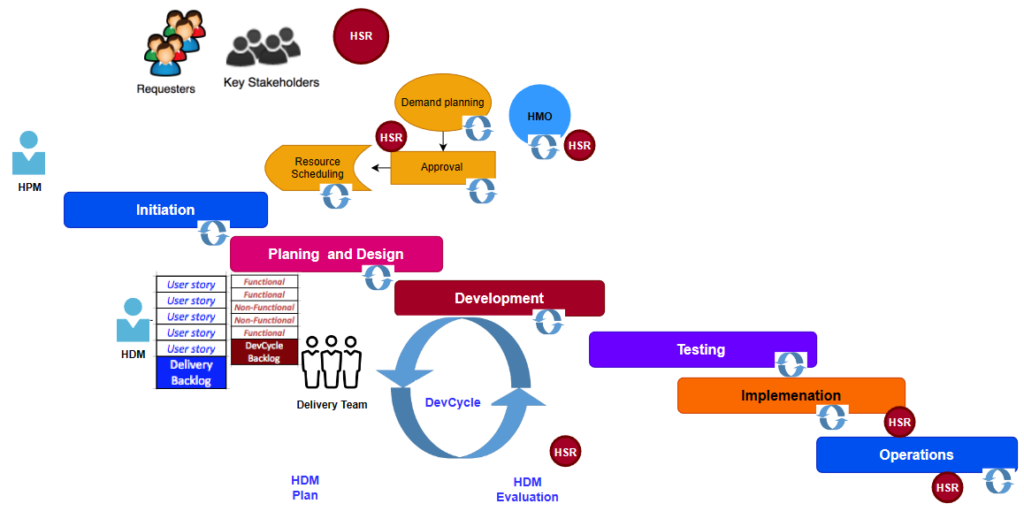BEA Hybrid Delivery Implementation Approach
In the realm of enterprise architecture, there have been numerous large-scale failures. These failures often stem from an approach that prioritizes technology and processes over the core business objectives. Traditional Enterprise Architecture (EA) often leads with technology and process, sidelining the business’s primary goals. BEAHUb.org recognizes this gap and offers a systemic approach that starts with the business. By leading out from the business and allowing for the seamless integration of technology and processes, BEAHUb.org ensures that the architecture is aligned with the organization’s core objectives and values.

Key Components and Elaborations:
- Demand Planning and Its Separation:
- Rationale for Separation: Given that project demands fluctuate with changing organizational needs, it’s crucial to separate demand planning. By doing so, we maintain a flexible approach to project intake, enabling the organization to pivot as required without disrupting established workflows.
- Demand Creation: Initiators or requesters channel their needs into the Business Enterprise Architecture projects, ensuring that projects align with current requirements.
- Stakeholders and Their Influence: While not always directly involved in project processes, key stakeholders shape the trajectory and priorities, necessitating their inclusion in the wider view.
- Hybrid Management Office (HMO): Replacing the traditional PMO, the HMO oversees the integration of Agile into the Waterfall structure, ensuring that projects remain adaptive without losing their direction.
- Waterfall Methodology – Detailed Stages and Agile Integration:
- Overview: Each stage of the Waterfall process, from initiation to operations, provides a structured backbone for projects.
- Initiation: This stage lays down the blueprint, establishing the project’s scope, direction, and objective.
- Planning & Design: Here, the core strategies and designs are developed. It is within this stage that the Agile phase becomes particularly prominent. The HPM takes the lead, understanding the broader objectives, translating them into Agile deliverables, and liaising with the HDM.
- Development: The outputs from the planning stage are converted into actionable tasks. Simultaneously, the Agile cycle ensures that this development remains iterative, responsive, and aligned with initial goals.
- Testing, Implementation, and Operations: Each of these stages also incorporates Agile cycles, ensuring that the final output remains in tune with user expectations and the changing landscape.
- Pervasive Agile Cycles: Within each Waterfall stage, Agile is not just an add-on but a deeply integrated component. Its iterative ‘dev cycles’ are infused into every phase, allowing for continuous feedback, evaluation, and recalibration.
- Deep-Dive into Agile Phase:
- Creation of the Delivery Backlog: The Agile phase becomes more pronounced between the initiation, planning, and development stages of the Waterfall method. Here, the backlog is not just a list but a dynamic set of user stories and requirements derived from the structured Waterfall stages.
- Hybrid Project Manager (HPM) and Hybrid Delivery Manager (HDM): The HPM acts as a bridge, understanding both Waterfall and Agile, while the HDM operationalizes these into the Agile framework. This synergy ensures that there is no loss in translation, and projects remain aligned with both methodologies.
- Evaluations and Reviews: Outputs are subject to rigorous HDM Evaluations, ensuring that what’s developed aligns with user expectations. Additionally, the Hybrid Strategic Review (HSR) at each stage aligns project outputs with organizational strategy.
- Role Dynamics and the Concept of ‘Hats’: In the BEA Hybrid approach, roles like HPM, HDM, and those in the HMO are not fixed labels. They are ‘hats’ that individuals can wear. A person can wear multiple hats, switching between them based on project requirements or phases. For instance, an individual could be the HPM in one project and take on HDM responsibilities in another. This flexibility in roles facilitates efficiency and streamlines resource allocation.
- Adaptability of the BEA Model: This unique model is versatile, applicable not only in Business Enterprise Architecture but also in domains like project management, change management, and process design.
To encapsulate, the BEA Hybrid Delivery Implementation Approach offers a structured yet flexible project management method. By intertwining Waterfall’s rigid structure with Agile’s adaptability, it addresses the dynamic nature of project demands while ensuring organizational objectives are never sidelined.